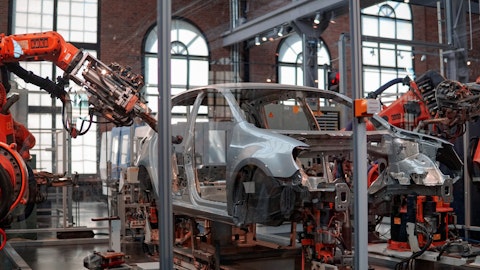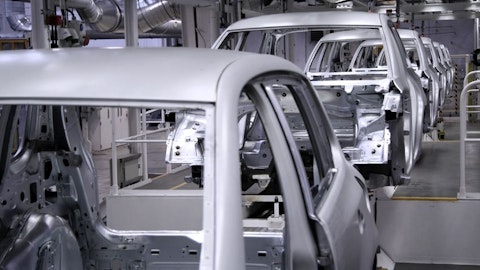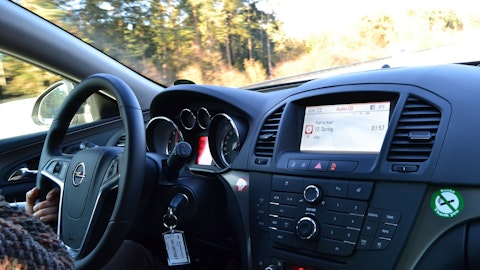Visteon Corporation (NASDAQ:VC) Q3 2023 Earnings Call Transcript October 26, 2023
Visteon Corporation beats earnings expectations. Reported EPS is $2.35, expectations were $1.86.
Operator: Good morning. My name is Anna and I will be your conference operator today. At this time, I would like to welcome everyone to the Visteon Third Quarter 2023 Earnings Call. After the speakers’ remarks, there will be a question-and-answer session. [Operator Instructions] Ryan Wentling, you may begin your conference.
Ryan Wentling: Good morning. I’m Ryan Wentling, Vice President of Investor Relations and Treasurer. Welcome to our earnings call for the third quarter 2023. Please note this call is being recorded and all lines have been placed on a listen-only mode to prevent background noise. Before we begin this morning’s call, I’d like to remind you, this presentation contains forward-looking statements within the meaning of the Private Securities Litigation Reform Act of 1995. Forward-looking statements are not guarantees of future results and conditions, but rather are subject to various factors, risks, and uncertainties that could cause our actual results to differ materially from those expressed in these statements. Please refer to the page entitled Forward-Looking Information for additional details.

A customer smiling delightedly after driving away in their new car from the automotive retail shop.
Presentation materials for today’s call were posted on the Investors section of Visteon’s website this morning. Please visit investors.visteon.com to download the material if you have not already done so. Joining us today are Sachin Lawande, President and Chief Executive Officer; and Jerome Rouquet, Senior Vice President and Chief Financial Officer. We have scheduled the call for one hour and we’ll open the lines for your questions after Sachin and Jerome’s remarks. Please limit your questions to one question and one follow-up. Thank you for joining us. Now I will turn the call over to Sachin.
Sachin Lawande: Thank you, Ryan, and good morning, everyone. Thank you for joining our third quarter 2023 earnings call. Page 2 provides a summary of our results for the third quarter. The company performed very well, delivering strong results for the quarter and strengthening our foundation for long-term growth. Third quarter sales were $1.14 billion. And excluding the impact from supply chain related pricing, our base sales grew 9% year-over-year, further demonstrating the strong demand for our digital cockpit products. Adjusted EBITDA was $128 million or 12.6% of sales, an increase of $33 million when compared to last year, driven by strong growth in our underlying business and a few favorable commercial items. As a result of our strong performance year-to-date, we are increasing the midpoint of our adjusted EBITDA guidance for the full year.
Adjusted free cash flow was a positive cash inflow of $98 million bringing our year-to-date cash flow to $93 million. The company delivered another quarter of strong product sales growth despite some emerging headwinds in the industry. In North America, our sales remained solid and the UAW strike had an immaterial impact to our sales as our Detroit customers continued to receive products throughout the quarter. In Europe, the strong order backlog at our customers has normalized due to weaker consumer demand, resulting in vehicle production at our customers coming in lower than we had initially anticipated. In China, vehicle production excluding exports was lower as well due to weaker consumer demand. With the market shifting more to electric vehicles, domestic OEMs in China are gaining market share over global carmakers, which is resulting in a negative customer mix for Visteon in that region.
Despite these headwinds, Visteon’s product sales grew in the third quarter due to the ramp up of recently launched products. We launched another 33 new products in the third quarter, bringing our year-to-date total to over 100 new products, which will continue to drive our sales in the coming quarters. Our product and technology portfolio for digitalization and electrification is one of the best in the industry, which is a big driver of our new business win performance. In the third quarter, we won $1.8 billion of new business, bringing our year-to-date total to $5.8 billion. I am also happy to report that we won our first customer for our automotive app store product that we highlighted at our Investor Day and during CES earlier this year.
These new connected services enable us to offer end-to-end solutions for carmakers, which is unique amongst our peers. In the third quarter, we continued deliver on the capital allocation commitment announced during our Investor Day and we repurchased an additional $46 million of shares bringing our total to $76 million through Q3. I will provide more details on our Q3 performance as well as our near-term outlook on the subsequent pages, before handing it over to Jerome to discuss the financials. Turning to Page 3. Global vehicle production in the third quarter grew 4% year-over-year, although Visteon customers’ vehicle production was flat for the quarter. The fast growth of electric vehicles, mostly by new OEMs that tend to be vertically integrated, combined with the slow start of global OEMs in this segment is one of the main drivers of this negative customer mix.
As we anticipated, semiconductor supply has gradually improved throughout the year. And in the third quarter, our open market purchases of chips were down significantly compared to last year. Excluding the unfavorable year-over-year impact from supply chain recoveries, Visteon’s base product sales grew 9% year-over-year in the third quarter despite flat vehicle production at our customers and resulting in a robust growth over market of 9%. From a sequential perspective, our base product sales have continued to grow sequentially from Q1 of this year, mainly driven by the ramp up of recently launched products. Through the first three quarters, our base sales have grown a solid 17% versus the same period last year. Digitalization is one of the most significant trends in our industry and in Q3, our digital products including digital clusters, SmartCore and infotainment performed very well.
Digital cluster sales grew more than 20% year-over-year, continuing the strong performance from prior quarters. Digital clusters now represent 60% of our total cluster shipments and this share will grow further in the coming quarters. There’s ample runway for future growth for digital clusters, especially in the mass market segment where this trend is just starting to make its impact. Displays are growing rapidly in automotive, both in size as well as the number of displays used in cockpits. Despite this positive industry backdrop, we are being impacted this year by the ramp down of a large program with BMW, which is masking the overall performance of this product line. We are quickly approaching the end of production of that program, therefore, it will be less of a headwind going forward.
As new display programs come online, we expect this product line to return to growth. SmartCore was our fastest growing product in Q3 with sales growing 25% year-over-year. We benefited from new launches with Harley-Davidson and Volvo and from the ramp up of programs launched earlier with Geely and Mahindra. This key product line now represents a mid-teens share of our total sales, up from the mid-single digits just a few years ago. We are also seeing rapid growth of our infotainment systems product line, especially Android based infotainment. Standalone infotainment systems featuring Android and offering connected services are an attractive proposition for many markets, especially for competitively priced vehicles. Lastly, our electrification business continued to ramp up in Q3 with the launch of additional electric vehicles by our customers.
While sales of BMS for the first three quarters have run lower than anticipated, we are pleased to see sequential growth in BMS sales, which we expect will continue in the coming quarters. In summary, Visteon continues to benefit from the digitalization trend and sales of our digital cockpit products were very robust in Q3. Turning to Page 4. We had another very successful quarter of product launches in the third quarter. The company launched its products in 33 vehicle models, which brings our year-to-date total to over 100 vehicle models launched with Visteon products across 18 different car manufacturers around the world. Our third quarter launches reflects the trend of digitalization impacting the industry across all vehicle segments. About two-thirds of our product launches were clusters with the remainder being cockpit domain controllers and displays.
Some of the key third quarter launches are highlighted on this page. With Mercedes, we launched multiple digital clusters as mid cycle updates to existing models and on the new EQE electric SUV for the China market. Our collaboration with ECARX in China continues to grow and in Q3 we launched our SmartCore cockpit domain controller on the Volvo EX30 electric SUV. As highlighted last quarter, we continue to make inroads in the two wheeler market. Commuter bikes make up the bulk of this market and these vehicles are just beginning their digitalization evolution. In Q3 we launched a digital cluster with Honda on the Giorno+ model that is offered in Japan and other countries in Southeast Asia. We anticipate this segment to continue to evolve quickly toward larger displays and connected cockpits in the future.
We had multiple launches with Ford in the quarter with our cluster and audio products, including on the transit light commercial vans in Europe and China. In Europe we launched our 8 inches hybrid cluster on two variants of the vehicle and a dual display and digital cluster system on China market variants highlighting the acceleration of digitalization trend in that market. We launched our first digital cluster for a heavy commercial vehicle with the launch of a 12 inch digital cluster with Renault trucks in Europe. Additional launches are planned with this OEM in the coming quarters. India is one of the faster growing automotive markets this year and our business is gaining momentum with carmakers in that region. In Q3 we launched our 7 inch digital cluster on 2 models with Tata Motors, including on the Nexon, which is the best-selling electric vehicle in the market.
Turning to Page 5. Q3 was another quarter of strong new business wins with $1.8 billion of business booked in the quarter, bringing our year-to-date total to $5.8 billion. About 40% of our wins year-to-date are for electric vehicles, reflecting the growing share of EVs in the industry, especially for the back half of the decade. On the right side of the page, we highlight a few key wins for the third quarter. First, we won a cockpit domain controller platform program with a German luxury OEM, our first CDC program with this customer. This product will launch on all ICE and EV vehicles from this car manufacturer starting from 2026 onwards and will integrate digital cluster and connected infotainment features and functions. This conquest win is Visteon’s largest cockpit domain controller win to-date.
Since launching our first Android-based infotainment system in 2020, we have upgraded our offering with new more powerful silicon and additional features including our AllGo App Store, OTA, smart voice assistant and camera-based features such as surround view. We believe we have the most advanced infotainment system in the industry today, especially for mass market vehicles. In Q3, we won an Android-based infotainment system business with a global OEM for their vehicles in South America, which will go into production in 2025. Visteon’s display capabilities are well recognized in the industry with our leading optical bonding and glass cover lens technologies. The third win highlighted on this page is a 25 inch multi-display module and a separate 10.25 inch passenger display for a global OEM we launched on an all-electric midsized SUV in the U.S. This is our first display win with this OEM and we’re excited about the potential to grow with other vehicle models in the future.
We have previously discussed our intent to bring advanced automotive specific connected services to the market. I’m proud to announce that we have won our first business for our in-house developed AllGo App Store with a large OEM in India. Our white labeled app store will be hosted and run by the car manufacturer to bring downloadable apps to their vehicles in the field. In addition, we also won our first customer for OTA services with a 2-wheeler OEM in the quarter. We believe that the timing is right for offering connected services in automotive and we are excited about its potential. Turning to Page 6. Car manufacturers are responding to consumers’ increasing expectations of digital and connected experiences in the cockpit and are increasingly equipping new cars with built in connectivity to the Internet.
Digitalization of the cockpit has led to the acceleration of the connected car trend with vehicles across all price segments offering connected experiences in the cockpit. In addition to Internet connectivity, consumers expect their cars to include downloadable apps like they get with their smartphones and tablets. Unlike the closed infotainment systems of the past, the transition to Android-based infotainment opens the possibility of bringing third-party apps into the vehicle cockpit. Visteon has been at the forefront of the digitalization trend and is also the leading supplier of Android-based infotainment systems. It was logical that we take the next step and offer connected services that leverages our in-vehicle expertise and closes the gap between mobile devices and in-car infotainment for apps and content.
Our AllGo App Store is a white labeled software-as-a-service offering that enables car OEMs to provide a full-fledged app store experience with their in-vehicle infotainment systems. We’re continuously growing the ecosystem of supported apps on the App Store and also offer value added testing and lifecycle management services to the car OEMs. Our analytics dashboard and deployment portal can be used by OEMs to deploy and manage apps that are offered on the App Store. We also offer additional cloud services on the AllGo SaaS platform that are addressing critical needs of OEMs. We offer an over-the-air service that enables OEMs to run full software update campaigns across their entire vehicle fleet in the field. Our subscription management service enables consumers to opt in or out of services such as premium content for navigation maps.
These services are offered standalone or bundled with the App Store. In addition, we are developing vehicle analytics and remote command services to provide seamless access to critical vehicle health and diagnostics information from consumers’ smartphones. Our near-term objective is to reduce friction for OEMs to adopt and deploy these services widely in their vehicles. Therefore, while the initial revenue contribution from the AllGo services will be minimal, the long-term opportunity is substantial. Our two connected services wins in Q3 demonstrate the revenue opportunities with our connected services that’s differentiated from our traditional model. We believe there are significant cross-selling opportunities both to serve our existing infotainment and SmartCore customers and to use our services platform to establish relationships with new customers.
We have a healthy pipeline of additional opportunities for these cloud services that we are currently engaged on and hope to report more progress in future quarters. Turning to Page 7. This page shows our sales and revenue performance year-to-date and the outlook for remainder of the year. We entered the year with the industry being supply constrained due to the lower vehicle production in prior years. With semiconductor supply improving and growing macroeconomic concerns, we had anticipated vehicle production at our customers to moderate due to slowing demand during the second half of 2023, which is happening. The transition from ICE to EV is also occurring more slowly for global OEMs than they had anticipated. Despite these challenges, Visteon’s product sales have increased sequentially each quarter this year.
The company’s strong product portfolio for the digital cockpit has enabled us to take advantage of the digitalization trend that is sweeping across the industry. The Company has performed very well operationally, launching a high number of products on vehicle models that are driving our revenue growth. This growth accelerated in the third quarter despite a challenging customer and vehicle mix environment. On the other hand, sales of our BMS product have come in below our expectations due to the challenges faced by global OEMs in ramping up electric vehicle production. Looking ahead to the fourth quarter, our performance will be driven by similar factors that drove our third quarter results. Ramp up of recently launched products will drive robust growth over market even with a slower ramp in BMS sales.
We anticipate semiconductor supply to continue to improve with fewer critical parts, which will also reduce our open market purchases and the corresponding revenue. China will remain a challenge for global OEMs as they will struggle to maintain their market share against domestic competitors, especially in electric vehicle segment. And lastly, the UAW strike at our customers’ plants will create greater impact to our sales in Q4 than what we experienced in the third quarter. We anticipate that our fourth product sales will grow sequentially as compared to the third quarter despite the headwinds. Our full year sales including recoveries are expected to come slightly below the midpoint of our previous guidance range due primarily to lower recoveries in BMS sales.
However, we anticipate our full year adjusted EBITDA will likely be slightly higher than the earlier midpoint due to our strong operational performance through the first three quarters, which we expect to continue into the fourth quarter. Turning to Page 8. In summary, the company performed very well to achieve another quarter of strong sales growth and positions us well to meet our full year profitability targets. We delivered record base sales with strong growth relative to our customers’ vehicle production continuing the trend of our performance for the past few years. The team continued to execute on our commercial and operational plans, which resulted in a strong adjusted EBITDA margin of 12.6%. We continue to build momentum by launching our products on 33 vehicle models and winning $1.8 billion in new business in the quarter.
Finally, we are updating our full year guidance for revenue and adjusted EBITDA to reflect the strong performance year-to-date and the current outlook for customer demand. Now, I will turn the presentation over to Jerome.
Jerome Rouquet: Thank you, Sachin, and good morning, everyone. Visteon posted a solid set of financial results in Q3, demonstrating another quarter of commercial and operational discipline. We continue to build momentum with our sales growth, margin expansion and cash flow generation. Q3 sales were slightly over $1 billion and when excluding the impact of supply chain recoveries, grew 9% compared to prior year. This strong performance was supported by the ongoing demand we see for our digital clusters, cockpit domain controllers and BMS programs combined with the benefit of recently launched programs. While the UAW strike has added significant uncertainty to the automotive market in North America since mid-September, the impact was immaterial on our third quarter performance.
Semiconductor supply has continued to improve and as a result, our reliance on open market purchases has significantly reduced year-over-year. However, we continue to see elevated prices from our traditional Tier 2 suppliers. In the third quarter, we shared approximately $70 million of these higher costs with our customers. We are optimistic that the semiconductor market will continue to improve in the coming quarters and expect that the need to pass through these costs will decline over time. Adjusted EBITDA was $128 million for the quarter, an improvement of $33 million versus prior year. Adjusted EBITDA benefited from higher base sales, improved operational efficiencies, lower engineering spending, as well as the timing of several favorable commercial items.
This was partially offset by an increase in SG&A expenses. Our adjusted EBITDA margin was 12.6%, but adjusting for some of the positive commercial items in the quarter, as well as for a more normalized engineering spend, our run rate was closer to 11%. Adjusted free cash flow was $98 million in the quarter, benefiting from a strong EBITDA and a reduction in working capital. We ended the third quarter with a net cash position of $144 million while being able to execute $46 million of share repurchases in the quarter. Our total share repurchases have been $76 million since we launched the program earlier this year. Overall, we delivered a strong performance in the third quarter. More importantly, we continue to build momentum and make progress towards our medium-term targets.
Turning to Page 11. Sales were $1.14 billion, relatively flat compared to prior year. When excluding customer recoveries, base sales were $945 million, an increase of 9% compared to prior year. This increase in base sales was driven primarily by growth over market as Visteon customer production was fairly flat in the quarter. Our growth over market was largely driven by the ongoing demand of our digital cockpit products, recent product launches and increased BMS demand. Customer recoveries, which are illustrated in the dotted boxes, declined year-over-year by 55% to approximately $70 million, driven mostly by a decrease in open market purchases and the corresponding recoveries from our customers. Open market purchases were minimal in the third quarter and we expect this trend to continue in the fourth quarter.
Recoveries related to higher costs from our traditional Tier 2 suppliers are expected to remain stable in the fourth quarter. As a reminder, recoveries, although bucketed as pricing, are passed through in nature, increasing sales, neutral for adjusted EBITDA, but diluting margin percentages. Adjusted EBITDA was $128 million for the quarter, versus $95 million compared to the prior year, an increase of 35% year-over-year. The primary improvement in adjusted EBITDA was due to higher base sales, improved operational efficiencies and several favorable commercial items we negotiated in the quarter. Net engineering declined 4 million year-over-year due to the timing of specific projects. This was offset by adjusted SG&A, which increased $4 million year-over-year, primarily due to personnel costs related to investments in our team to support our future growth.
Turning to Page 12. We maintain one of the strongest balance sheets in the industry. Our balance sheet supports our growth and provides the flexibility needed to pursue our capital allocation priorities. We ended the quarter with total cash of $485 million and a net cash position of $144 million. In the third quarter, we repurchased shares for $46 million at an average price of $137 per share. This brings our year-to-date share repurchases to $76 million. We will remain opportunistic in future share repurchases, which will depend on several factors, including our free cash flow generation and industry dynamics. We generated $93 million of adjusted free cash flow through the first nine months. This is a $133 million improvement as compared to the first nine months of the prior year, primarily due to higher adjusted EBITDA and lower working capital build, partially offset by higher cash taxes and higher capital expenditures.
As anticipated, the built in trade and other working capital from the first half of 2023 was partially reversed in the third quarter. Cash taxes were higher than prior year due to cash payments related to increasing profitability in some jurisdictions. Interest payments remained low and primarily relate to our term loan that matures in 2027. We have now repaid approximately $8 million year-to-date as a result of our quarterly amortization payments. These modest amortization payments will continue on a quarterly basis through the maturity of the facility. CapEx was $82 million in the first nine months. We expect CapEx to increase in the fourth quarter, reflecting seasonality and our ongoing investments in manufacturing and electrification. We continue to expect CapEx of around $130 million for the full year.
Turning to Page 13. In light of our strong performance and the various factors impacting the industry, we are updating our guidance. For sales, we are tightening our guidance range to $3.950 billion to $4.025 billion. The midpoint of just under $4 billion represents a strong 14% year-over-year growth in base sales for the full year. Our underlying performance is expected to remain strong in the fourth quarter, with continued growth over market driven by ongoing product launches and an increase in our BMS sales, although lower than originally anticipated. As Sachin mentioned earlier, there are several emerging headwinds that are expected to weigh on our fourth quarter sales, including the customer mix headwinds in China, weakening demand from our European customers and the impact of the UAW strike.
Our Detroit customers have only recently reduced their orders due to the UAW strike actions. In our guidance, we have assumed that the strike will continue at yesterday’s levels through Thanksgiving, which has an estimated impact on our sales of approximately $6 million to $7 million per week. Our guidance ranges do not incorporate further escalation of the strike either in duration or in the number of OEM plants being impacted. For reference, our weekly revenue from the Detroit 3 is $20 million to $25 million per week. We’re tightening our adjusted EBITDA range upward to $415 million to $445 million. This is primarily from the momentum of strong underlying operational performance. However, above average decrementals on lost sales as a result of the UAW strike are expected to be a headwind for the fourth quarter.
For SG&A and net engineering, we continue to expect the second half of the year will be roughly flat with the first half in dollar terms. We’re maintaining our adjusted free cash flow range of $115 million to $165 million which considers our assumption of the current adjusted EBITDA range, a modest use of working capital, and higher CapEx spending in the fourth quarter. Turning to page 14. Visteon remains a compelling long-term investment opportunity. We have positioned the company for top line growth, margin expansion and free cash flow generation. We will continue to return cash to shareholders while maintaining a strong balance sheet, which provides significant flexibility. We have an exciting growth profile and have demonstrated a strong focus on operational and commercial discipline to deliver this growth.
Thank you for your time today. I would like now to open the call for your questions.
See also Hedge Fund Manager Louis Bacon’s Top 12 Stock Picks and Duquesne Family Office’s 15 New Stock Picks.
Q&A Session
Follow Visteon Corp (NYSE:VC)
Follow Visteon Corp (NYSE:VC)
Operator: [Operator Instructions] Your first question comes from the line of Luke Junk with Baird.
Luke Junk: I guess I’ll take the obvious topic to start with, just the UAW strike in. I’m just curious beyond the impacts to sales and operations that are downside risks, do you see any silver linings to the strike in terms of, I guess, thinking in a tight supply chain environment, potentially reallocating chips, maybe building safety stock, continuing to drive down the open market purchases, things like that? That’s the first question. Thanks.
Sachin Lawande: Hi, Luke. Good morning. Yes, indeed. I mean we are looking at all opportunities, not just the UAW strike to improve our performance in the supply chain. Just maybe take a step back where we are at with semiconductor supplies. Although supply has gradually improved all throughout the year, which has been a good thing and that has lowered our dependence on spot buys. There are still a few chips that are critical and we’re watching them very carefully. In general, I would say the investments in capacity and efficiency of fabs that we’ve discussed previously have delivered in terms of higher supply, but demand from automotive has not gone down much unlike some other sectors. So while we have maybe taken some benefit from the lack of demand on the other sectors, I would say that we still have a few chips that we need to work on, that we are trying to build a level of safety stock.
And any reduction in demand whether through the strike or any other factor, would help in terms of building up that safety buffer. So that’s where we stand.
Luke Junk: And then my second question, a bigger picture question, Sachin, and that’d just be in terms of the customer reaction to the first power electronics win that you announced last quarter. Just curious if you have a better understanding of Visteon’s opportunity in power electronics and just general position in the market. And I guess my impression is that, that part of the market is still somewhat immature, but I would think to go out there now with a actual award in hand that would be a pretty meaningful factor?
Sachin Lawande: Yes. Your description of the market as being immature, I think is very apt. And that is what I hear when I go out and talk to customers about power electronics. Now just to set some context, the industry is going through the shift from 400-volt architectures to 800-volts and that’s creating new requirements for power electronics, which are quite significant and have caused a lot of challenges for OEMs. Now, these challenges existed even with the 400-volt architectures in terms of power electronics. And specifically we’re talking about products like high voltage junction box, DC to DC converters and onboard charges. But when you go up to 800-volts, the requirements get that much more difficult and especially in terms of efficiency, rate and volume and very importantly thermal management.
And since we are addressing many of these concerns, there’s a lot of interest at OEMs in our solutions. So the way I would characterize this is, yes, it has — this win that we announced last quarter has put us on the map. It has made us a legitimate supplier of this in the systems in the industry that has generated a lot of discussions and interest at OEMs. But I feel like we will still need a couple of more quarters before we can fully understand the full potential for us in this particular space. We remain very optimistic.
Operator: Your next Question comes from the line of Dan Levy with Barclays.
Dan Levy: I’m wondering first, Jerome, if you could maybe just give us a bit of a bridge from 3Q to 4Q. I appreciate that part of the decline is going to relate to the non-repeat of some of the commercial items. You also had some strike. But I’m wondering, if you could also just sensitize for us given the strike just ended last night for your largest customer within the D3 or should be any?
Jerome Rouquet: Sure, Dan. So maybe let’s go back to Q3 for a moment. We’re very pleased with how the quarter developed. Growth over market was 9%. Our sales grew as well by 9% in a flat customer environment to production for us. Our EBITDA run rate when you normalize for some of the timing items that we had was close to 11%. So it does two things: First, it confirms the good run rate that we had indicated we would have in Q3 at the end of Q2; and then it allows us to raise the midpoint of our EBITDA guidance while absorbing some level of strike. So talking about Q4 and looking at Q4 versus Q3. On the EBITDA side, we are still seeing some benefits from extra volumes, even though we’ve got some impact of strike baked into our midpoints.
And we won’t see obviously the onetime items that I’ve called out in my prepared remarks, which are impacting our Q3 results by about 100 basis points. And then what we’ll have in Q4 is a little bit more engineering cost than we had in Q3. We had a fairly low level of cost in Q3 in engineering, largely because of again timing, and we’ll see some ramp up of these costs in Q4. So overall still a very good quarter, we will be closer to 11% overall in Q4 in terms of EBITDA. As far as the strike is concerned, we’ve been watching obviously the news and the announcement from yesterday, may change the dynamic on the strike obviously. We still are exposed obviously to GM, not just to Ford, and we’ll have as well to see how the ramp up of some of the Ford and GM or Ford plants materializes.
We are a little bit unclear as to whether an office ramp up will be straightforward and without any hiccup. So this is something we’re watching very closely and we’ll take it from there from now.
Dan Levy: Of the — you said weekly revenue of $20 million to $25 million of that is for the D3, what percentage of that is Ford, presumably the majority is Ford?
Jerome Rouquet: It’s a little bit more tilted towards Ford, but it’s — GM is still a fairly large impact for us. I think one other aspect to consider is the fact that we are already pretty much at the end of October, and we’ve had already more than a month of strike impacting orders for the month of October. So we should take that into account as well as we think about the strike. There’s already some level of impact that has been going through our numbers.
Dan Levy: And then as a follow-up, wanted to ask about obviously the slowdown or the reduced excitement about EVs that we’re seeing probably in the market. Maybe you could just give us a sense of how we should think about the BMS piece of your backlog in light of the slowdown to be. I think we’ve generally seen OEMs reserve some of their best or more advanced content for EV platforms. I know you’re really ICE-agnostic outside of BMS. If OEMs are slowing down the pace of some of these launches, how does that impact broader uptake of your content, which has generally been reserved for the more high profile launches?
Sachin Lawande: Yes, let me take that. This is Sachin. So I would say that in general, the high content is not just specific to EVs. You are right, but there is more higher content, especially digital content in EVs across the board. What we have seen and this has happened in Q3 and we expect that to continue into Q4, as our customers have had some challenges in production and sales of EVs that has dampened our digital cluster sales by a little bit. Although, as I mentioned in my prepared remarks, digital clusters have grown still very well, 20% year-over-year. So that’s still pretty strong. Our cluster volume is pretty large and we can absorb this impact of the slowdown coming from EVs. Now on the BMS front, again as I mentioned earlier, our BMS sales continue to grow quarter-over-quarter and the ramp up we expect to continue into Q4 and in the subsequent quarters.
Now in next year, we have additional BMS launches as well. And at the same time in terms of our estimates, we don’t necessarily take our customer data at face value. So we have had some level of conservativeness in our estimates. So we expect to continue to grow quarter-over-quarter. In terms of where we are at, I expect that our exit rate this year in Q4 to be where we thought we would be at the beginning of the year. So yes, it has taken a little bit longer for us to its stride. It has still grown pretty well from our estimation. And our earlier estimates of about 5% revenue contribution from BMS this year will be lower than that, but we expect to be able to catch up next here, but we’ll need to wait until the end of the year to fully understand our customers’ production plans and the BMS contribution next year.




